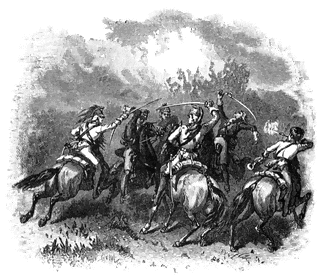The Battle of Cowpens on this day in 1781 is recorded as a turning point in the American Revolution.
Americans were planning cautiously, dispersing into smaller units and contemplating how to minimize direct confrontations with the British. America’s Continential Brigadier General Morgan knew he was being chased by professional soldiers led by a young British Lieutenant Colonel Tarleton. The British leader had a reputation for aggressive and brutal tactics. Morgan then realized Tarleton was nearing them as the Americans approached a river in Cowpens, South Carolina. The Continental General decided it would be wiser to take a stand against the coming British there instead of being engaged as they tried to cross.
Several important factors were in play when Tarleton headed towards the resting American forces.
The British were exhausted and out of food from non-stop marching through the night and crossing rivers in the cold of winter while the Americans waited. The British were confident in their superior numbers, methods and training while the American General set an unsual trap that reduced Tarleton’s advantage from aggression (it not only was a trap for the British but also for the Americans — no way out may have given volunteers and irregulars confidence to stand and fight).
It was in this context that Tarleton predictably and proudly herded his men straight into the American lines. When the Americans fired and withdrew, according to their plan, the British rushed ahead in expectation of an easy victory. However, instead the British ran into additional lines of Americans and flanking movements. These new lines had been obscured by the first line’s retreat. The withering fire from men standing ahead was coupled with the fact that the retreating men stopped, turned, regrouped, opened fire and charged the exhausted British.
The trained British attackers were decimated and broken. Survivors fell into disarray in the face of Americans orchestrating rearward movements, obscure defensive lines, a double envelopment and bold re-engagement.
It appeared to the British, when Howard’s line fell back, that victory was at hand, and so it would have been, had the line been composed of men less inured to battle than were the Continentals of Maryland and Delaware. There was no delay or hesitation when the order to halt, face the enemy, and fire, was given, and there then occurred in a moment a scene of dumbfounded surprise, confusion, and panic seldom witnessed in battle. The outcome resulted in one of the most gloriously unexpected victories of the Revolutionary War.
Unable to regain control of his men, who were disorganized and confused by the resistance and fast becoming unwilling to fight, Tarleton tried to rally. He failed and instead just managed to escape after shooting the horse out from under Colonel William Washington.

The encounter between Tarleton and Colonel Washington. by E. Benjamin Andrews in 1895, from the Florida Center for Instructional Technology
British General Charles Cornwallis soon after consoled Tarleton. The loss of nearly 80% of their men at Cowpens was given this assessment:
…total misbehavior of the troops could alone have deprived you of the glory which was so justly your due.
Just ten months later the Revolutionary War would end with Cornwallis’ surrender.